Who would have thought that printing on textiles would evolve so much that today we can print whatever we have on our mind on whatever surface we like? (DTF) Direct-to-film printing is one of the most popular digital printing techniques that has become the talk of the town because it has taken the custom apparel printing industry by storm. After all, who wouldn’t enjoy the benefit of transferring designs onto various surfaces, from garments to promotional products, within the blink of an eye? So, let’s explore the inside out of DTF printing, everything from the basics, process to advanced techniques.
What is DTF Printing Technology and How Does It Function?
Custom merch manufacturing is at its peak today, thanks to a growing demand for high-quality apparel and accessories, including t-shirts, hoodies, socks, caps, beanies, mugs, coasters, phone cases, etc. Today, digital printing has evolved so much that it seems effortless to print anything on any surface.
Among several processes that come under the digital custom merch printing umbrella; DTF printing, short for direct-to-film printing, is a revolutionary technique that has been disrupting the market with its efficiency and versatility.
It is an act of transferring intricate designs onto various surfaces. From customized apparel to promotional merchandise, DTF printing offers high-quality, detailed prints directly onto films that are then transferred onto textiles be it polyester, cotton, silk, or synthetic fibers like rayon or terrycotton, because the DTF printing process works like magic on all of them.
The DTF printing process is simple and straightforward. The design to be printed is created or uploaded onto a computer which is then transferred to a specialized DTF printer where the design is printed onto a special film with a coating, using water-based inks, and powder adhesive, and is then printed onto the garment or other substrates using a heat press. The result is high-quality, vibrant, and durable prints.
DTF Printing Market Status
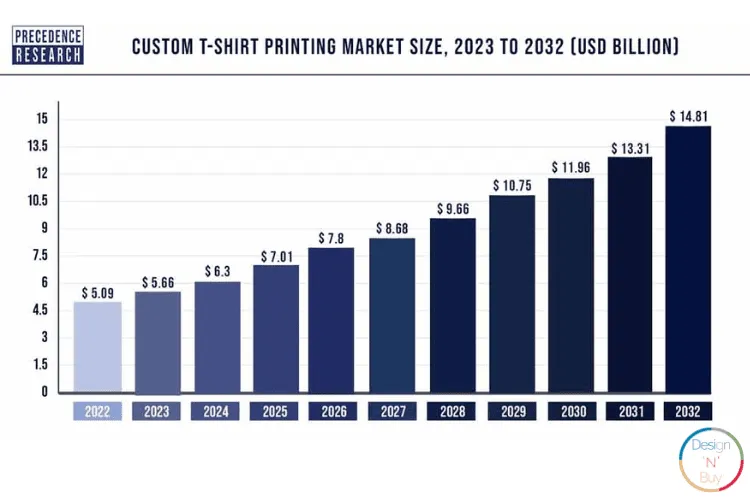
DTF (Direct-to-Film) printing has rapidly disrupted the market due to its versatility, cost efficiency, and exceptional product quality. Its innovative printing method has gained a significant advantage over traditional techniques, especially in meeting the growing demand for intricate and custom designs.
Unlike conventional methods, DTF printing allows for detailed and complex designs, making it ideal for personalized apparel and specialty items. Its ability to print on both white and dark garments further expands its applications, catering to a wide range of customer needs. With its continuous growth, DTF printing is reshaping the landscape of custom printing and is becoming a popular choice among garment manufacturers and printing businesses.
In fact, the market size for digital textile printing which is valued at US$ 2,714.5 million in 2023 is anticipated to be worth an estimated $1.7 billion by 2026.
If you’re looking for content related to printing methods, you can consider the following topics:
Sublimation vs. Heat Transfer: Which Printing Method is Right for You?…Read More
Digital vs. Offset Printing: Why Inkjet Printing Is Growing And Worth Investing In?…Read More
Offset Printing vs Digital Printing: Pros, Cons, and Considerations…Read More
DTF Printed Products That Can Be Put Up For Sale
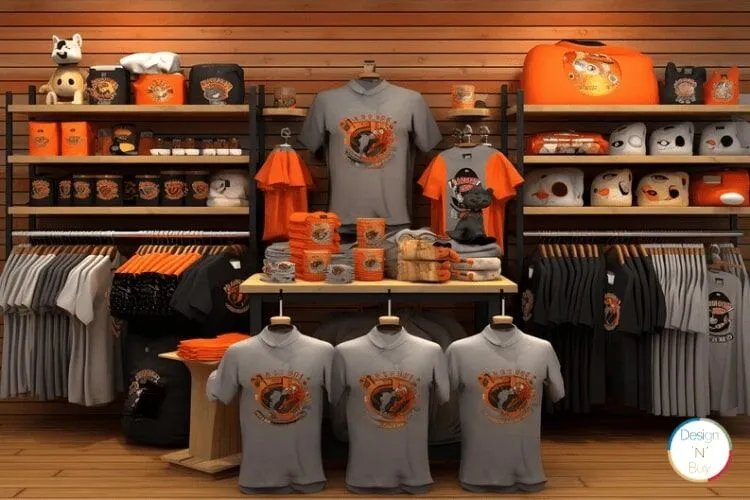
Garments, accessories, and promotional items; DTF printing technology makes it possible to create a wide range of printed products to sell. Here are some ideas:
DTF Printing Business Essentials
- Custom Apparel
- T-shirts
- Hoodies
- Sweatshirts
- Tank tops
- Jackets
- Accessories
- Caps/hats
- Socks
- Scarves
- Bags (tote bags, backpacks)
- Bandanas
- Home Decor
- Pillow covers
- Towels
- Blankets
- Curtains
- Wall art (posters, canvas prints)
- Personalized Items
- Phone cases
- Laptop sleeves
- Mugs
- Water bottles
- Mousepads
- Sportswear
- Jerseys
- Sports bras
- Yoga pants
- Athletic shorts
- Promotional Products
- Keychains
- Magnets
- Stickers
- Custom labels
- Pet Accessories
- Pet bandanas
- Pet shirts
- Pet beds
- Event Merchandise
- Concert or festival merchandise (t-shirts, posters)
- Sports event merchandise (team jerseys, caps)
- Wedding favors (customized apparel, accessories)
- Holiday and Seasonal Items
- Christmas sweaters
- Halloween costumes
- Easter-themed apparel
- Valentine’s Day gifts
- Specialty Clothing
- Activewear (sports bras, leggings)
- Workwear (customized uniforms for businesses)
- Fashion items (dresses, skirts)
What things are needed to get started with DTF Printing? There are certain essential items that you will require to kickstart your DTF printing business. Here’s a comprehensive list of things to begin with:
DTF Printer:
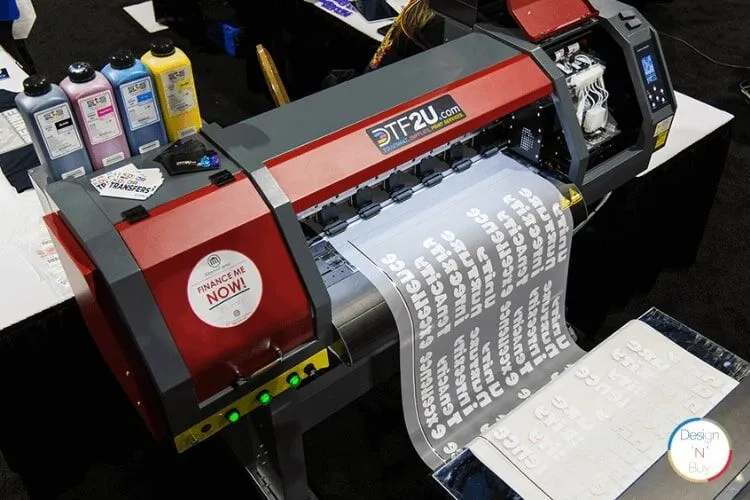
To print on the film you will need high-quality specialized printers alternatively known as DTF Modified Printers to handle the unique requirements of DTF technology. They use special 6-color inks and hence provide the convenience of operation as CMYK. It has a mechanism to prevent the appearance of linings on the white layer and prints with precision and accuracy.
DTF printers are available in a variety of sizes and configurations to meet the demands of both small businesses and large-scale production operations. Popular brands include Epson and Ricoh printers modified for DTF printing.
PET Films:
Transparent PET films made from polyethylene terephthalate are used as a base for printing the designs in the DTF printing process. They should be compatible with your DTF printer. These films are different than those used in screen printing as they have a thickness of around 0.75mm and superior transmission capabilities.
DTF films are available in two forms: cut sheets, which are used for small-scale applications, and rolls, which are used for commercial setups. In addition, they are classified according to how they are peeled after the transfer has been completed. In terms of temperature, the films are classified as hot-peel or cold-peel.
DTF Printing Software:
Specialized DTF printing software that is compatible with the printer model and can handle CMYK and White Colors. is essential for processing your designs and sending them to the DTF printer because the Software plays a great role in the print characteristics, the color performance of the inks, and the final appearance of the print on the fabric after it has been transferred.
DTF Printing Ink:
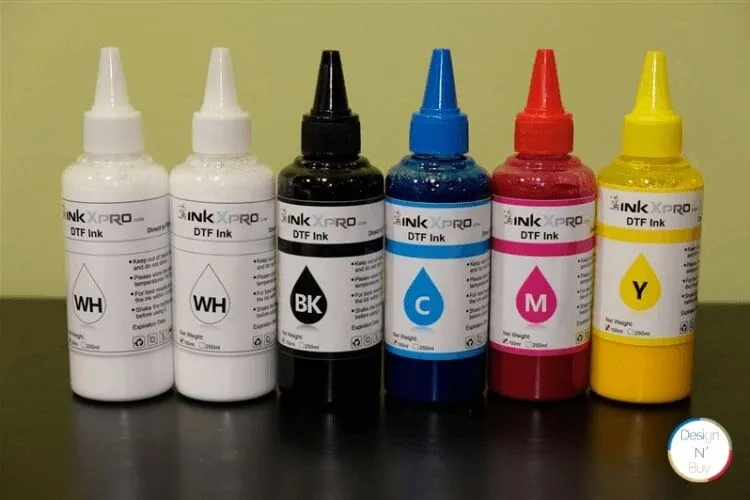
There are specifically formulated pigment inks available in Cyan, Magenta, Yellow, Black, and White colors for direct-to-film printing among which the white ink holds much importance as it lays out the foundation of the print on the film and onto which the colored design is printed. These inks are crucial for achieving consistent and high-quality vibrant, durable prints.
Hot-melt Adhesive Powder:
Adhesive powder or DTF printing powder is a white adhesive material that is applied on the PET film after printing to bond the color pigments of the design to the fibers in the fabric and prepare it for transfer. Several micron-sized grades of DTF hot melt powder are available in the market among which an appropriate grade should be selected based on requirements.
Automatic Powder Shaker:
A powder shaker evenly distributes the adhesive powder over the printed design and removes the excess powder ensuring uniform application.
Heat Press Machine or Curing Oven:
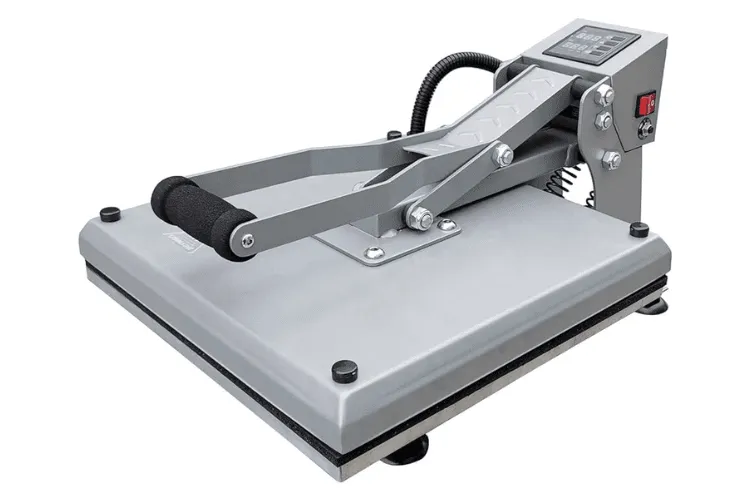
After printing and applying the adhesive powder, the PET film is pressed onto the fabric using a heat press machine. Alternatively, some setups use a curing oven to fix the design onto the fabric.
Quality Control Tools:
Tools like magnifying glasses and color meters can help in inspecting the print quality and color accuracy.
Check out some of our other great content here
Step-by-Step Guide to Starting An Online T-shirt Printing Business…Read More
How to Start a Printing Business from Home: Step-by-Step Guide…Read More
The DTF Printing Process: A Step-by-Step Guide
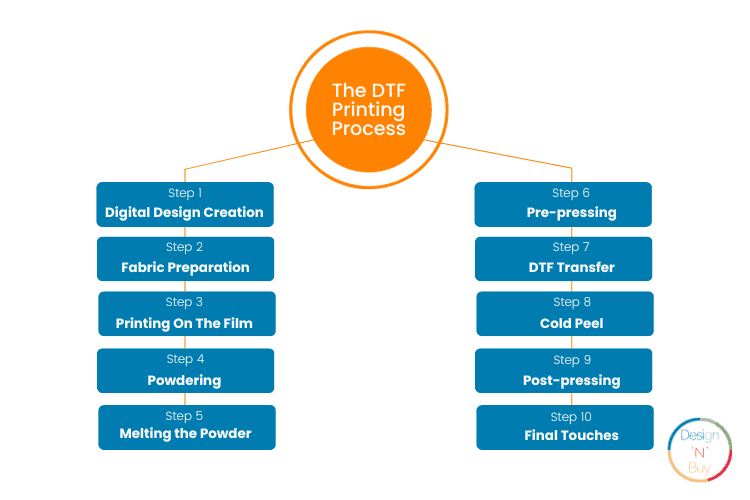
You checked the compatibility of things required for DTF printing, you have the essentials, now comes the printing process. Let’s understand each step in detail.
Step 1 - Digital Design Creation
Utilize graphic design software such as DesignO to design the desired design. Make sure the design has a high resolution and is suitable for printing.
Step 2 - Fabric Preparation
Choose the appropriate fabric for your project. The fabric should be compatible with DTF printing and pre-treated with a special coating that allows the ink to adhere properly. Apply a pre-treatment solution to the fabric for it to accept the ink better and enhance the color vibrancy and wash resistance of the print.
Step 3 - Printing On The Film
Load PET film into the printer trays. Begin by printing the entire image in white onto the PET film. Subsequently, adjust the printer settings to the desired colors and print the required image on top of the white layer. It is crucial to note that the image printed on the film must be a mirrored version of the final design intended for the fabric.
Step 4 - Powdering
In this step, a hot-melt powder is applied to a film that has an image printed on it. Remember to apply it evenly when the ink is wet and remove the excess powder carefully. You can either do it yourself by sprinkling ink on the print and then seesaw back and forth until the wet ink is covered with ink and shake off the excess or seek the help of an automatic powder shaker.
Step 5 - Melting the Powder
The next step is to melt the spread powder which can be done in various ways. You can either directly put the film with the printed image and applied powder in a curing oven and bake for 2 minutes which is the most common way to melt the powder or place it inside the heat press and bring the top of the press very close to the film but not touching it i.e. keep about 4 to 7 mm gap between the film and heat press top plate and heat for 2 to 5 minutes with the temperature around 160 to 170 degrees Celsius.
Step 6 - Pre-pressing
Pre-pressing fabric is an important part of the DTF printing process because any wrinkles in it will show up in the print. So, the fabric is kept in the heat press and pressurized under heat for about 2 to 5 seconds to flatten, smooth, and de-humidify it to make sure the image is transferred correctly from the film to the fabric.
Step 7 - DTF Transfer
One of the most crucial moments is when the print is transferred to the fabric. The PET film with melted powder is placed on the pre-pressed fabric in the heat press for a strong adhesion between the film and the fabric. The whole process is also called ‘curing’ which is carried out at a temperature of 160-170 degrees for 15-20 seconds approx., which causes the film to attach to the fabric firmly.
Step 8 - Cold Peel
Allow the heated fabric and film to cool down to room temperature and peel the film from the fabric.
Step 9 - Post-pressing
Although an optional step, it is recommended if you want the best results and high-performance parameters like wash and rub fastness. The final fabric with the transferred design is pressed in the heat press for around 10 to 15 seconds to produce a pretty amazing transfer.
Step 10 - Final Touches
The printed fabric is inspected for color accuracy, sharpness, and overall quality. Any defects or issues should be addressed before further processing. After the quality inspection, it can be cut and sewn into the final product, such as garments, home textiles, or promotional items. Perform a final quality check on the finished products to ensure that the printing has been successfully transferred without any flaws. The finished products are then packed appropriately for distribution and shipped to customers or retailers.
Utilize our print workflow modules to enhance your print production processes, minimizing expenses, preventing reprints, and promoting efficient waste management !
DTF Printing Pros

Direct-to-fabric (DTF) printing offers several advantages, making it a popular choice in the textile industry. Here are some of the key pros of DTF printing:
- Suitable for a variety of fabrics, including cotton, polyester, silk, and blends.
- Provides high-resolution and vibrant prints with intricate details.
- Allows for easy customization of designs.
- Provides a softer feel to prints compared to traditional screen printing, making them comfortable to wear, especially on apparel items. It’s like the ink becomes part of the fabric, resulting in a smooth finish.
- Offers relatively fast production turnaround times.
- Unlike traditional printing methods that require extensive setup, DTF printing is cost-effective for short runs.
- When properly cured and post-processed, DTF prints exhibit good durability and wash fastness.
- Can be environmentally friendly, depending on the type of ink used. Some DTF inks are eco-friendly and water-based, reducing the environmental impact compared to solvent-based inks used in other printing methods.
- Does not have limitations on the number of colors in a design.
- Minimizes wastage of ink and materials since it allows for precise control over the amount of ink used for each print job.
DTF Printing Cons

While direct-to-fabric (DTF) printing has many advantages, there are also some limitations and challenges associated with this printing method. Here are some of the cons of DTF printing:
- While direct-to-film DTF printing is relatively fast for short runs, it may not be as efficient as other methods like screen printing for large-scale production.
- Compatibility between DTF inks and fabric materials is crucial. Using incompatible inks or fabrics can result in poor adhesion, color bleeding, or reduced durability of the prints.
- Compared to sublimation printing the feel and color of the print is slightly low.
- Some DTF inks contain chemicals that can be harmful to the environment if not disposed of properly.
- DTF printing equipment requires regular maintenance and calibration to ensure consistent print quality. If not properly maintained, the printing results may suffer, leading to wasted materials and time.
Tips to Get Your DTF Printing Business in Motion and Succeed
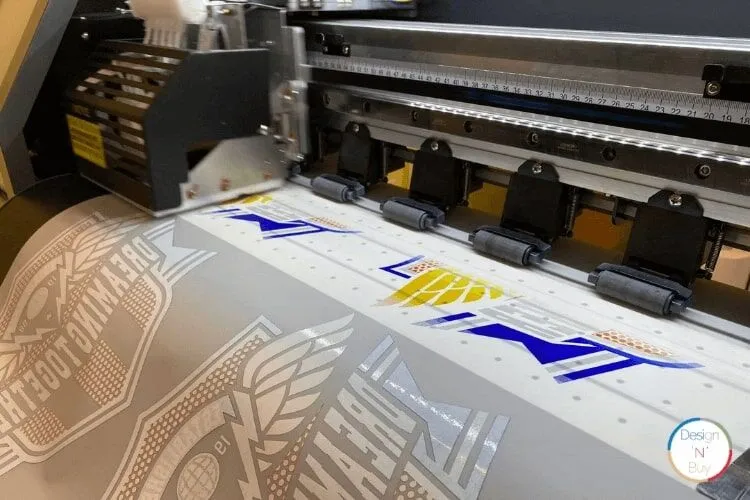
Starting and growing a DTF printing business requires a strategic approach that includes maximizing efficiency and productivity, utilizing specialized software, optimizing your online presence, and implementing effective marketing tactics. Here’s a guide tailored to your ultimate goal:
- Start by understanding the DTF printing process thoroughly. Once you master the technique, identify your target market, including local businesses, events, or online stores that might need custom fabric printing.
- Define your niche. Calculate your startup costs, including equipment, materials, space, and marketing. Plan your budget and financial projections.
- Register your business. Obtain any necessary licenses/permits. Consider business insurance for equipment and liability protection.
- Purchase reliable DTF printing equipment, including printers, curing units, and pre-treatment machines. Set up a well-ventilated workspace due to the involved chemicals.
- Partner with fabric suppliers for a variety of fabrics suitable for DTF printing, including cotton, polyester, and blends. Source high-quality DTF inks and pre-treatment solutions.
- Develop a user-friendly print website showcasing services, portfolio, pricing, and contact details. Leverage social media to promote your brand and engage with your customers. Find a web to print vendor that can provide you fully functional storefront integrated with an online design tool to offer custom designs.
- Enforce strict quality standards for each print. Test different fabrics and designs for process optimization.
- Invest in web to print software that automates order processing, reducing manual errors and saving time. Manage orders, designs, and inventory from a centralized dashboard, streamlining operations. Offer clients personalized portals to upload designs, check proofs, and place orders, enhancing customer experience.
- Provide excellent customer service. Ensure timely responses and attention to detail. Optimize your website for relevant keywords related to DTF printing for online visibility and to attract organic traffic. Prioritize local SEO to reach customers in your region. Ensure your business is listed accurately in local directories and Google My Business. Create engaging and informative content related to direct to film DTF printing. Blogs, tutorials, and FAQs not only improve SEO but will also position you as an industry expert.
- Attend local events and trade shows, and network with potential clients and collaborators. Partner with local designers and businesses for mutual benefits.
- Keep up with the latest trends and technologies in direct to film DTF printing. Solicit customer feedback and use it to constantly improve your services.
Aspiring DTF Printers, Attention!
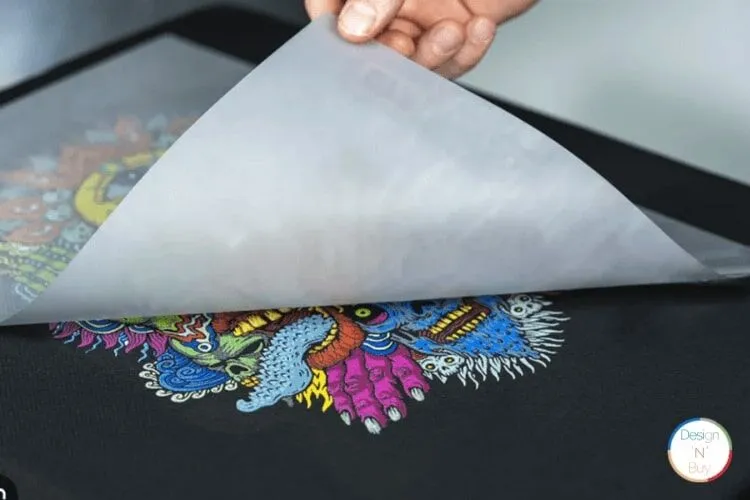
The quick and cost-effective way to print detailed designs on various fabrics is what made DTF printing the showstopper today. However, it’s crucial to approach DTF printing with the right knowledge, equipment, and skills to maximize its benefits.
Investing in quality DTF printing equipment, understanding the nuances of fabric and ink compatibility, and providing excellent customer service are key factors in ensuring the success of a DTF printing business.
Additionally, staying updated with printing industry trends, embracing technological advancements, and adapting to customer needs can help businesses thrive in this competitive market.
As with any technology, the effectiveness of direct to film DTF printing is maximized when combined with a solid business strategy, a focus on quality, and a dedication to meeting customer demands. With these elements in place, DTF printing can indeed be a game-changer for businesses seeking efficient and cost-effective fabric printing solutions.
More for you
- Top 8 Print MIS Software in 2024…Read More→
- Top 10 Wholesale Promotional Product Suppliers in the United States…Read More→
- 9 Best Screen Printing Machines of 2024…Read More→
- Top 5 Print Estimating Software…Read More→
- Best Large Format Printers of 2024…Read More→
- Top 10 DTG Printers (Direct-To-Garment) With Prices…Read More→
- Top 10 Best DTF Printers (Direct To Film Printer) For Tshirt And Promotional Merchandise Printing…Read More→




